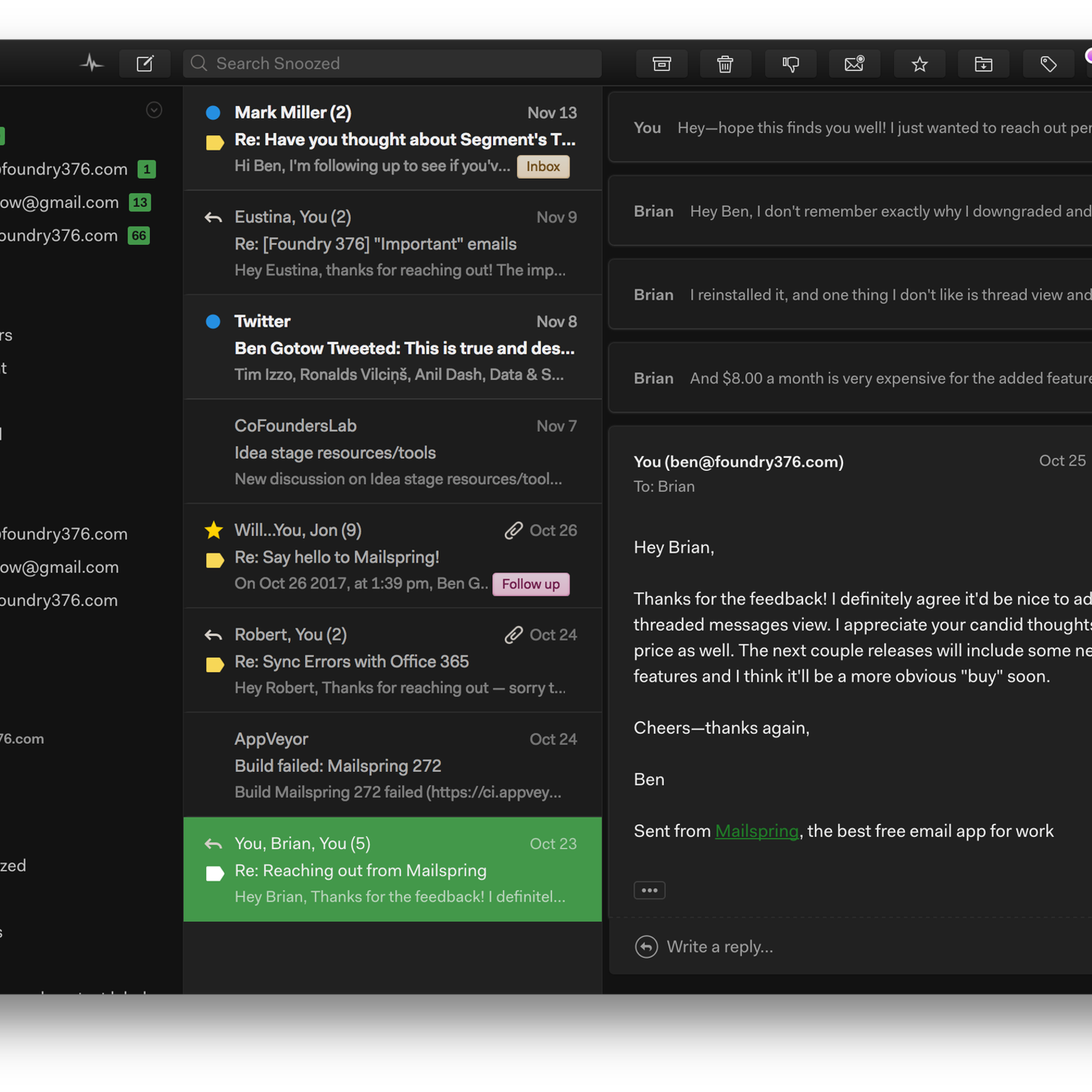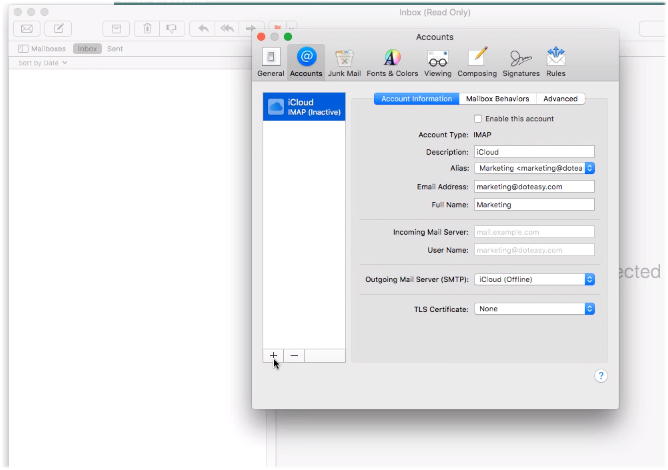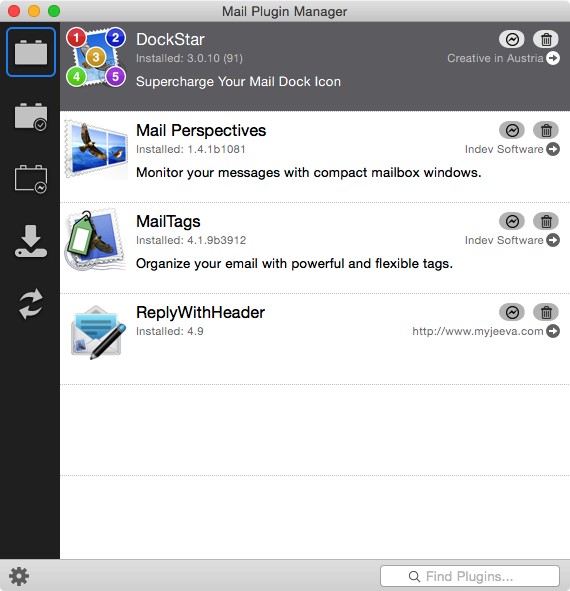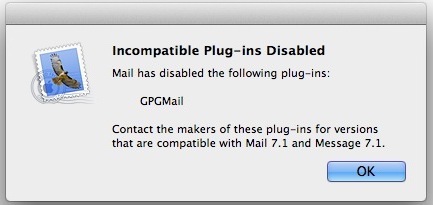That said, this should work for a majority of Mail plugins, though if it doesn’t you may have to consult the instructions offered by the developer. And don’t forget to enable the plugin once you’re finished. (Image credit: Laptop Mag) 1) Download the plugin you want to use with Apple Mail. Mail Plugin Manager for Mac. Mail Plugin Manager for Mac. Free SmallCubed Mac OS X 10.10/10.11/10.8/10.9 Version 2.2.5 Full Specs. All Rights Reserved. Deze site gebruikt cookies. Melding sluiten x.
Check tutorial of How to Uninstall Plugins from the Mac Mail App in Mac OS X


So after a lot of requests from our users here is a guide about How to Uninstall Plugins from the Mac Mail App in Mac OS X.
There are plenty of useful Mail plug-ins available for Mac OS X, but sometimes using them wears out, or the plug-in isn’t updated for a new version of the Mac Mail app, rendering it unusable. If you’ve ever wanted to remove a Mail plugin in Mac OS X, you’ve probably found that, unlike Safari, there is no plugin manager available from the app preferences. Instead, you have to manually remove the plugins for the Mail app by deleting the affected files. This is not the most intuitive process in the world, but it is not too complicated either.
Note that once you are in the file system, Mail plugins are called “Mail Bundles”, which are generally folders with a .mail bundle suffix. There are actually two locations where Mail app plugins can be stored depending on how they are installed and what they are for. It’s best to check both locations when removing plugins to troubleshoot.
Remove system-wide email plug-ins in Mac OS
These are plugins installed to be system wide, meaning all user accounts on the Mac can access them through the Mail app.
- Close the Mail app
- From the Mac OS X Finder, press Command + Shift + G and navigate to the following path:
- Find the plugin you want to remove, usually called “PluginName.mailbundle”, and drag it to the trash
- Restart the Mail app when done
/ Library / Mail / Bundles /
The next up, check the folder of the user’s email plug-in. The path looks almost identical, but they are two separate locations on the Mac file system.

Remove user mail plugins in Mac Mail

You will also want to check the folder of the user mail bundles, the process for removing the user plugins is the same as above except the folder path is different:
- From Mac OS X Finder, hit Command + Shift + G and focus on the following path:
- If necessary, delete the plugin (with the suffix .mailbundle) by dragging it to the trash
- Restart the Mail app
~ / Library / Mail / Bundles /
If you go to one of the / Library / Mail / Bundles / folders and find them empty, it is because the plug-in (s) are not in that location or are no longer active. Assuming Mac OS X has disabled the plug-in itself, you can usually find these disabled plug-ins in the following location:
~ / Library / Mail / Bundles (disabled) /
You can also just go to the parent folder to find both “Bundles” folders:
~ / Library / Mail /
This process is the same for all versions of Mac OS X and for all versions of the Mac Mail app.
Beyond the general utility, removing Mail plugins can also become a necessary procedure if the Mail application crashes randomly or generally misbehaves, especially after a new plugin is installed. If you are only testing a plug-in’s compatibility, you may want to temporarily move it to a different folder instead of the trash, and then rebuild the mailbox before trying again. You should also make sure that the plugin is the most recent version as updates can fix many compatibility issues.
This is also the same process you should undertake if you ever encounter an ‘Incompatible plugins disabled’ welcome screen when launching the Mail app, which tells you which plugins were disabled, but again, does not provide any executable details or plugin -in administrators to delete them. If you see this type of window warning:
Repeat the steps above to find the affected plug-in, remove it and relaunch the Mail app. The warning box should now be gone and the Mail app will run as usual.
How to Uninstall Plugins from the Mac Mail App in Mac OS X Guide is free?
This guide is a free model
Free Trial: May be included, please check on the official site, we mentioned above.
The How to Uninstall Plugins from the Mac Mail App in Mac OS X tutorial price is Free or Freemium. This means you can truly enjoy the How to Uninstall Plugins from the Mac Mail App in Mac OS X guide.
The How to Uninstall Plugins from the Mac Mail App in Mac OS X guide gives you an easy-to-use and efficient management and How to Uninstall Plugins from the Mac Mail App in Mac OS X allows you to focus on the most important things. It’s friendly guide to use maybe you will love it and How to Uninstall Plugins from the Mac Mail App in Mac OS X tutorial can be used on Linux, Windows or android devices.
How to Uninstall Plugins from the Mac Mail App in Mac OS X: benefits
- The How to Uninstall Plugins from the Mac Mail App in Mac OS X tutorial is free .
- Helps many users follow up with interest in a timely manner.
- The price of the How to Uninstall Plugins from the Mac Mail App in Mac OS X guide is free.
How to Uninstall Plugins from the Mac Mail App in Mac OS X: FAQ
Tutorial Summary: How to Uninstall Plugins from the Mac Mail App in Mac OS X
How this tutorial helping you?
What is actual time in which this method complete?
What are the supported Device?
What are the supported Operating system?
How to Uninstall Plugins from the Mac Mail App in Mac OS X Tutorial: final note
For our visitors: If you have any queries regards the How to Uninstall Plugins from the Mac Mail App in Mac OS X, then please ask us through the comment section below or directly contact us.
Education: This guide or tutorial is just for educational purposes.
Misinformation: If you want to correct any misinformation about the guide “How to Uninstall Plugins from the Mac Mail App in Mac OS X”, then kindly contact us.
Want to add an alternate method: If anyone wants to add the more methods to the guide How to Uninstall Plugins from the Mac Mail App in Mac OS X, then kindly contact us.
Our Contact: Kindly use our contact page regards any help. You may also use our social and accounts by following the Whatsapp, Facebook, and Twitter for your questions. We always love to help you. We answer your questions within 24-48 hours (Weekend off).
Channel: If you want the latest software updates and discussion about any software in your pocket, then here is our Telegram channel.
WordPress is one of the most popular CMSs. In fact, more than 60m websites are built on WordPress!
And if you’ve landed on this page then you’re most likely one of many who make up that number. Whether you’re a blogger, have an ecommerce, a review site, or some other online business, WordPress is a powerful solution.
You’re no doubt looking for a just-as-powerful solution for your email marketing. Well, you’ve come to the right place. In this article, I’m going to take you through the pros and cons of using each of the WordPress email plugins on this list.
But first:
WordPress Email Marketing: Things to be Aware of
When it comes to selecting the right newsletter plugin for WordPress, there are a couple of very important things to bear in mind.
Security: WordPress sites are vulnerable to hacking attempts. Aside from using strong passwords and protecting access to your WordPress admin area, it’s important to make sure you’re using secure plugins that are up to date.
Using an outdated plugin or theme can make your site vulnerable. You’ll want to pick a plugin whose author will be quick to detect and fix any security flaws and bugs. You can see when each plugin was last updated in the preview window (see screenshot below).
You, as the user, will need to make sure your email plugin is regularly updated, as you wouldn’t want to be at risk of losing your email list to some hacker.
A safer alternative can be to use a service that doesn’t actually store your contact list in WordPress but in a separate database belonging to the newsletter service (e.g. Sendinblue). While you have to give away your data to a third party, it’s usually a much safer affair as these newsletter services have full control over the security of your list.
Ease-of-use: Designing and sending out your email newsletters should be a quick and pain-free task. You don’t want to find yourself with a clunky or buggy email newsletter plugin.
Designs: Like with any email service provider, you want to make sure that it comes with attractive and responsive email templates that you can easily edit to fit your needs.
Deliverability: What’s the point of sending out an email newsletter if it doesn’t reach the recipients? As you can see in our deliverability tests, not all email tools get the same results. You’ll want to choose a newsletter plugin that has deliverability as it’s main priority (along with security, of course). It might be that the plugin uses SMTP (Simple Mail Transfer Protocol) or integrates with a third-party service such as Mailgun, Sendinblue, Mailjet or SendGrid.
When you search for newsletter plugins within WordPress, you’ll see that plenty come up. You’ll also see how many people have rated it and how many active installations it has currently. This article looks at some of the most popular email and optin form plugins.
So, now that we know what we’re looking for, let’s dive in and check them out!
6 WordPress Email Plugins You Should Know About
1. MailPoet – Modern design templates
2. Sendinblue – Advanced form, automation and newsletter options
3. Email Subscribers & Newsletters (Icegram) – No third-party subscriptions required
4. Mailster – Target your audience with custom conditions
5. Newsletter – Free plan
6. OptinMonster – Targeted popups
MailPoet
Active installations: 100,000, plus 200,000 from the previous version
The fact that MailPoet has recently brought out a new version of its software should indicate that it’s a more secure, user-friendly plugin. It also claims to have a deliverability rate of 98.5%, due to the MailPoet Sending Service – so no need to use a third-party SMTP. It’s important to understand that your subscribers will be stored in WordPress, which means that it’ll be your job to keep the data safe.
What I liked about MailPoet
MailPoet offers really great email templates. There are 50 of them and they all have really modern designs.
It integrates directly with WooCommerce so if you have an online store you'll be able to easily add your products to your newsletters in the drag & drop editor. Updating subscribers on your latest blog posts and news is also hassle-free due to MailPoet’s automations.
This integration means that you can segment subscribers based on actions that have taken place in your store, for example, if a subscriber has bought a particular item or an item from a particular category. Even on the free plan, you can send unlimited emails to your subscribers.
You’re in full control of your list as you don’t have to upload it to any external service (of course you are also in charge of security, which is probably a disadvantage).
What could be improved
In order to find out who’s opening and clicking your emails, you’ll need to upgrade to the Premium plan.
Pricing
The free plan comes with unlimited emails, which you can send to up to 1,000 subscribers. Premium plans are available from $13/mo.
Try MailPoet for free or go Premium and get 30% off with this link
Newsletter, SMTP, Email Marketing and Subscribe Forms by Sendinblue
Active installations: 50,000
This is Sendinblue’s official plugin for WordPress. In order to use it, you’ll need to create an account with Sendinblue’s email marketing service.
We rate Sendinblue pretty highly due to its affordable prices and range of pro features. You can also get started for free with this plugin, though the sending limit is just 300 emails/day.
What I liked about Sendinblue
Sendinblue’s free plan includes marketing automation, transactional emails and SMS and unlimited contacts. The plugin works via an API so the interface looks basically the same as on the Sendinblue platform. This continuity is helpful if you’re going between the two.
The automation options available are pretty advanced. You can trigger campaign actions using your visitor’s email and website engagement behavior, assign lead scores, plus loads more.
Your contacts are stored in Sendinblue’s built-in CRM on its email marketing platform, thus making it much more secure.
What could be improved
The daily limit of 300 emails/day on the free plan is an issue.
Pricing
Free (unlimited contacts, 300 emails/day). Paid plans start from $25 for 40,000 emails/month
Try Sendinblue’s WordPress plugin
Email Subscribers and Newsletters (Icegram)
Active installations: 100,000

This very easy-to-use newsletter plugin for WordPress doesn’t require any third-party subscriptions or additional tools to send your newsletters. The interface is intuitive and the basic features should be enough to get started with, though this only comes with basic security, so I’d recommend paying a little extra to know your contact list will be safe.
What I liked about Icegram
You can easily set up autoresponders like welcome messages and emails notifying subscribers when you publish a new blog post.
A nice feature of the forms is that users can choose which list(s) they subscribe to when they sign up.
What could be improved
The custom fields you can add to forms are limited to name and email on the free plan.
There are a number of trigger options for automations available, but the majority are reserved for paying customers. If you’re on the free plan you’ll be limited to user registered, deleted or updated.
Log Into Mac Email
Pricing
Free for basic features (no SMTP support) and security or $9/month for SMTP, high security and premium email templates.
Try the Icegram plugin for WordPress
Mailster
Mailster offers a premium, paid plugin for your WordPress site.
The drag & drop editor makes setting up your email newsletters a simple affair. Its segmentation options allow you to better target your audience through the use of custom conditions.
It doesn’t include SMTP, but it’s compatible with many popular email sending services, such as SendGrid, Amazon SES and Mailgun.
What I liked about Mailster
Setting up forms is made simple by the use of a drag & drop builder. You can also easily add your forms to posts by using the shortcode generated – no need to play around with any code.
Advanced reporting and simple autoresponders like welcome emails and birthday messages are all available with Mailster.
There’s no limit to the number of forms, lists or subscribers you have.
What could be improved
Mailster comes with only a couple of the most basic templates. In the templates gallery, it seems there are plenty of options available but you’ll have to purchase them. Considering that this is a paid plugin, you’d imagine it’d have more in the way of designs.
Pricing: $59 for a one-site license and 6 months' support. Of course, you also have to factor in the price for an email sending service, as SMTP is not included.
Get Mailster
The Newsletter Plugin
Active installations: 300,000
The Newsletter for WordPress plugin is free and easy to set up, as you do not need any other tools or services to use this plugin. That said, it does give you the option of connecting to other SMTP plugins to help deliver your emails. We’d recommend you do so in order to get maximum results.
What I liked about Newsletter
The blocks available in the newsletter editor are a bit limited but it does allow you to easily add your blog articles and has a Giphy library, which could be a fun feature for some marketers who like to use GIFs.
You’ll get unlimited emails to unlimited subscribers, even on the free plan!
What could be improved
It doesn’t really offer much in the way of templates so you’ll need to build it yourself using the drag & drop editor or uploading raw HTML. Setting up forms isn’t the most intuitive as there’s no preview of what the code will look like on the frontend (as you’d see in a regular form builder).
If you want pro features like automations, advanced reporting and integrations then you’ll have to pay for them, starting from $65 for the year.
Pricing
Free plan with unlimited emails and subscribers. It has premium plans for pro marketers, which will cost you $65/yr (install it on up to 3 different websites) or $249/yr (unlimited sites) for a year of updates.
Additionally, you'll have to pay for an email sending service.
OptinMonster (For Optin Forms & Popups)
Active installations: 900,000
OptinMonster has the highest number of active installations of the plugins on this list. That’s a very good indicator of the quality of the plugin, as users are clearly very satisfied with the software.
OptinMonster specializes in optin forms and popups, so you can use it to get more interested people on your mailing list. Bear in mind that OptinMonster is used to generate leads but you’ll need to connect it to an ESP in order to send those leads your newsletters.
What I liked about OptinMonster
The range of popups is vast: exit popup campaigns, floating header or footer popup bars, slide-in popup boxes (also known as scroll triggered boxes), sidebar popup forms, inline popup forms, mobile popup campaigns, fullscreen welcome gate popups, and more. These are simple to set up with helpful templates, and, of course, are all mobile responsive.
The advanced targeting and segmentation options make it easy to reach the right people in the right moment. For example, you can show a coupon code popup to only new visitors on your site. Or perhaps you only want to show a popup about an event to people based in a certain city.
What could be improved
All plans are billed annually by default, which isn’t ideal for those who aren’t ready to commit for such a long time period. Also, because you’ll need a third-party service to send the emails, you’ll be looking at extra costs.
Pricing
Prices start at $9/month for unlimited campaigns, page-level targeting and 1 site. For $29/month the Pro plan will allow you to employ advanced targeting, countdown timers, you’ll be able to remove branding and use it on 3 sites.
Best WordPress Newsletter Plugin: The Verdict
As you’ve seen, there are plenty of great WordPress email plugins available. All of them are pretty affordable and some even free for limited features.
Best Free Newsletter Plugin For WordPress
Apple Mail Missing Plugin
MailPoet has an excellent free plan, which includes unlimited emails, SMTP and attractive design templates.
Apple Mail Add Ons
Most Complete Newsletter Plugin For WordPress
Sendinblue is the most comprehensive newsletter plugin for WordPress. The paid plan ($25/month) will allow you to set up advanced automations and send up to 40,000 emails to unlimited contacts. And because your contacts are stored in Sendinblue’s built-in CRM on its email marketing platform, you can rest assured that no hacker will be able to access your contact list via your WordPress site.
The Best Plugin For Optin Forms And Popups
OptinMonster has a ton of excellent form and popup options. The fact that you can use smart targeting based on your visitors’ location and interaction on your website means that your email list should grow rapidly and allow you to set up relevant automations for new leads.
Let me know how you get on! Are you using a WordPress email plugin that isn’t on this list? Let me know in the comments below.
Email Marketing Crash Course: Step by Step Guide
Change Mac Mail Settings
Our email marketing course for beginners – ideal for small and medium-sized businesses, online stores and bloggers. It shows you all the steps you need to send your first newsletter. Best of all, it’s free! Sign up to receive your copy immediately!
Email Marketing Crash Course: Step by Step Guide
Our email marketing course for beginners – ideal for small and medium-sized businesses, online stores and bloggers. It shows you all the steps you need to send your first newsletter. Best of all, it’s free! Sign up to receive your copy immediately!
Please note: From time to time we will also send you our newsletter. We will never share your email address with anyone other than our email service provider. And of course, you can unsubscribe at any time.
4 Apr 2017
What’s the Best Transactional Newsletter Service?
4 Dec 2018
The 14 Best Free Email Marketing Services - How far can $0 get you?
